1. The Arnolfini Portrait
Hidden within the walls of the National Gallery in London lies a masterpiece cloaked in mystery and rich detail, the "Arnolfini Portrait" by Jan van Eyck. This emblem of the Northern Renaissance commands attention not merely for its visual appeal but for the enigmatic elements it encapsulates.
At first glance, the painting presents Giovanni di Nicolao di Arnolfini and his wife, captured with striking realism. Yet, it is the layers beneath these lifelike figures that invite speculation and scholarly debate. The mirror in the background, small yet potent in its reflection, harbors more than just the room's depth; it tells the story of unseen witnesses, possibly even van Eyck himself, extending an invitation to explore truths beyond the surface.
The craftsmanship in the chandelier above is notable, missing a candle on one side – a detail often interpreted as symbolizing absence or loss. The singular lit candle could signify the presence of God watching over the scene. This interpretation aligns with the domestic sanctity portrayed, challenging viewers to see beyond the physical and contemplate the spiritual.
The apparent opulence in the room underscores poignant contrasts. The luxurious attire and interiors clash with the humble, barefoot stance of the woman, perhaps a subtle nod to purity or grounding in faith amidst worldly wealth. This duality enriches the painting's narrative, painting a complex tableau of 15th-century life that intertwines the sacred and the mundane, the visible and the invisible.
The "Arnolfini Portrait" transcends its subject matter to evoke discussions on love, commitment, and celestial surveillance, immortalized through van Eyck's genius. Its intricacy prompts us to consider the layers and dimensions within, making it a profound subject of analysis for art enthusiasts and historians alike. With each viewing, the portrait reveals more of its secrets, ensuring its enduring allure and mystery.
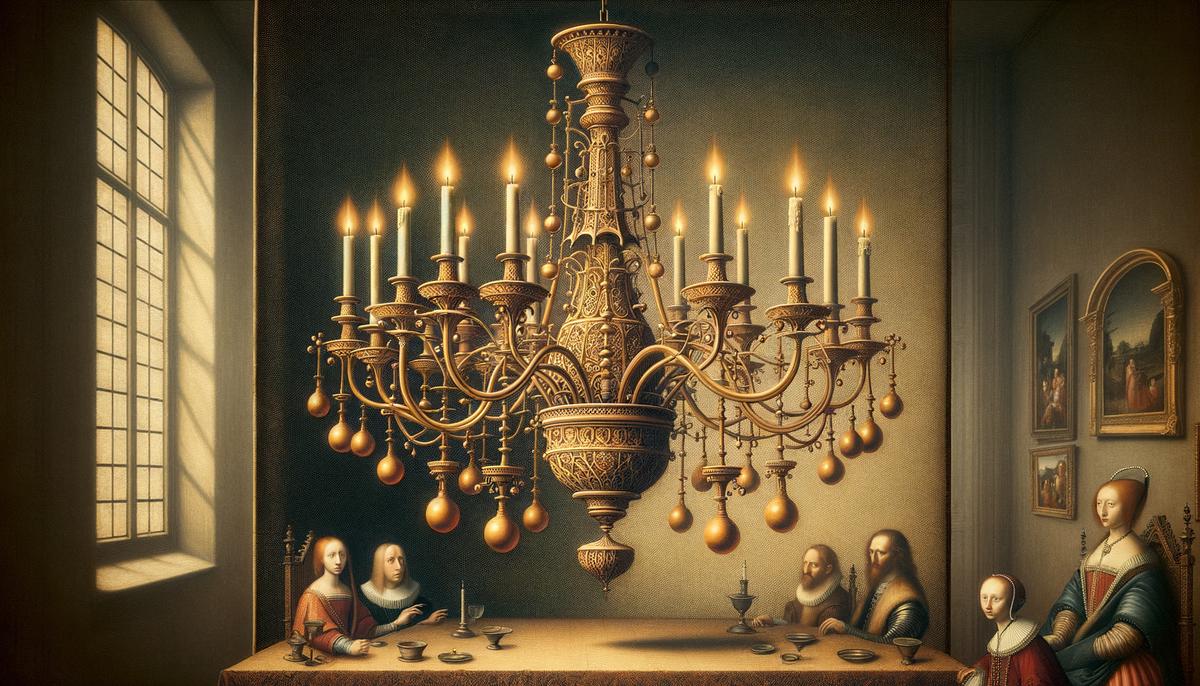
2. Rokeby Venus
Inside the grandiose halls of the National Gallery in London, amidst a wealth of timeless art, Diego Velázquez's "Rokeby Venus" tranquilizes the air with her ethereal presence. Unlike any other in Velázquez's oeuvre, this masterpiece intertwines themes of beauty, vanity, and the transient nature of existence within a delicate weave of oil on canvas. It challenges the conventions of its time and the gaze of every viewer who dares to unravel its enigma.
The Venus depicted isn't just a subject; she is an invitation to introspection. Velázquez has painted her lying on sumptuous fabrics, her body in a fluid curve that evokes the ephemeral nature of beauty. She turns away from the viewer, her face merely a haze in the mirror held by Cupid, suggesting a profound disconnection between her divine beauty and our mortal perception.
This deliberate act of turning away prompts a myriad of interpretations. Is it an assertion of her autonomy, refusing to be objectified by the viewer's gaze? Or perhaps, it is Velázquez's poignant commentary on the elusive essence of beauty itself – always desired, yet never fully comprehensible. As she gazes into the mirror, the reflection we are shown is not her own but rather a blurred visage that challenges our expectations.
This turning away could be seen as an exploration of vanity. The mirror, often symbolic of vanity, here presents a paradox. It reflects not the self-absorption of physical appearance but a meditation on the inward beauty that escapes our superficial scans. Venus, the embodiment of love and beauty, denies us her gaze, urging us to look beyond the facade and contemplate what true beauty encompasses.
In crafting this departure from the traditional motifs of female nudes in art, Velázquez transgresses aesthetic boundaries and instigates a dialogue on the nature of the voyeuristic impulse. "Rokeby Venus" postures as much more than a celebration of divine beauty. It serves as a mirror to our own inclinations, imploring us to question why we seek to possess or define what is inherently indefinable.
Her act of turning away leaves us suspended in thought, pondering on the fleeting reflection that mirrors not just a divine figure but the human condition itself. In this silent yet potent rebuke to objectification and shallow contemplations, Velázquez captures the essence of introspection—an enduring legacy that transcends time, inviting generations to reflect upon the fleeting moments of beauty and existence captured within the "Rokeby Venus."
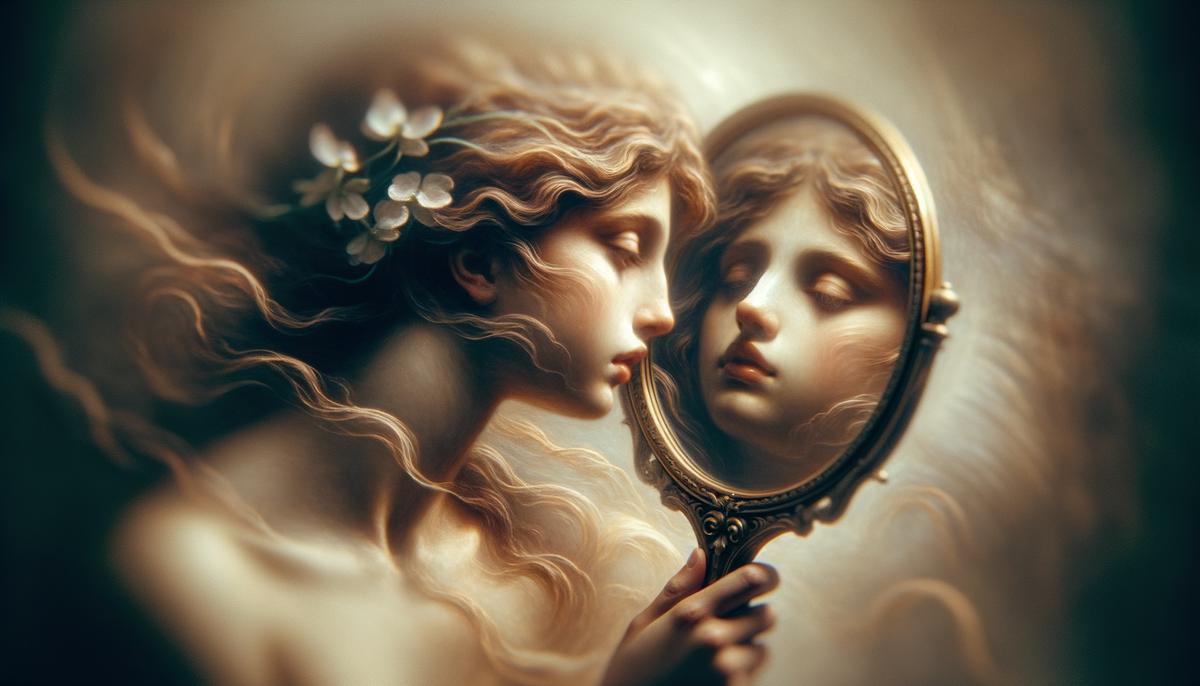
3. Sunflowers
Vincent van Gogh's "Sunflowers" stands as a beacon of color and passion within the National Gallery's extensive collection, drawing in countless visitors with its radiant warmth and vivid texture. The golden petals and hearty stems seem to pulse with life, captured in an eternal sun-drenched moment that begs for deeper contemplation. This masterpiece encapsulates more than the physical allure of these blooms; it invites the observer into a nuanced dialogue with mortality, impermanence, and the relentless pursuit of light in the face of darkness.
This iconic series transcends a simple still life; it is an emotional journey charted through the lifecycle of the sunflower. From the tender buds aspiring toward the sky to the full bloom basking in its prime and the inevitable wilt that follows, each stage is a testament to the cycle of life that Van Gogh observed with both a painter's eye and a philosopher's soul. It's within these layers that the artist's contemplations on existence and the boundary between life and death are meticulously braided into the canvas.
The emotive force behind "Sunflowers" taps into a universal chord, mirroring our own experiences with growth, peak, and decay. These flowers, though static, twist and turn as if dancing in the light, a phenomenon that may echo Van Gogh's unyielding zeal for capturing the fleeting moments of luminescence amidst personal turmoil.
What truly marks "Sunflowers" as a vessel of optimism is its celebration of the ordinary, elevated into the extraordinary through Van Gogh's perspective. There's an inherent joy in how these ordinary flowers captivate with such force on the canvas, suggesting that beauty and meaning can be cultivated from even the simplest sources of inspiration. This conviction, that amid the most challenging phases of life one can still find reasons for awe and gratitude, forges a connection between the painter, the painting, and the observer that transcends time.
Perhaps then, what Van Gogh was channeling through his "Sunflowers" was not solely an acceptance of life's ephemeral beauty but also an affirmation of resilience. These sun-kissed blossoms, set against a backdrop that vibrates with energy, arguably stand as symbols of hope. Despite their stint in the grand cycle of bloom and fade, there's a restoration in their very existence on the canvas – a revivification that suggests that, even at the end of one's bloom, the capacity to inspire and evoke joy remains unscathed.
In stepping back from "Sunflowers," what emerges alongside reflections on beauty's fleetness is an ode to living ardently and cherishing the luminal moments. Therefore, while underpinned by themes of temporality and reflection, Vincent van Gogh's sunflowers ultimately tilt toward the light of optimism, inviting viewers to bask in their eternal golden hour and perhaps, find solace in their steadfast glow amidst the ever-turning wheel of existence.
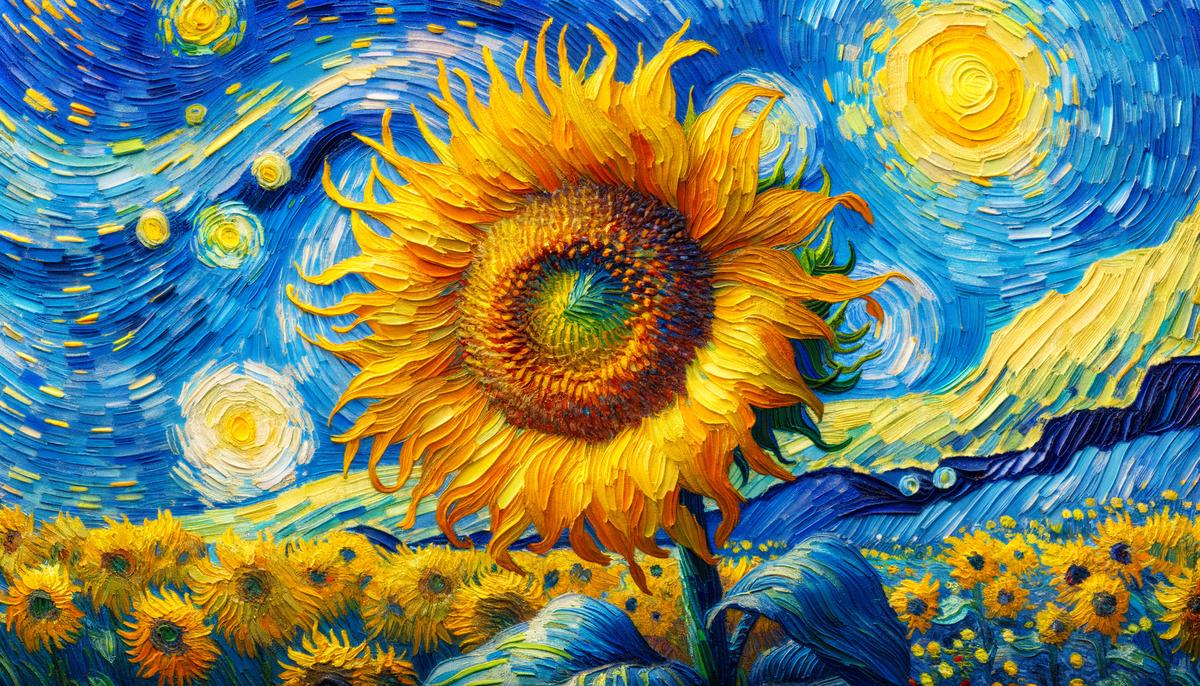
4. The Virgin of the Rocks
In the luminous corridors of the National Gallery, where art converses across the centuries, Leonardo da Vinci's "The Virgin of the Rocks" emerges as a transcendent puzzle wrapped in oil on wood. This painting entices the mind into the labyrinth of shadows and light that Leonardo meticulously crafts. Amidst its serene composure, it whispers questions of the sacred, the profane, and the profound mysteries that lurk within the folds of nature.
Leonardo, in this work, challenges the boundaries of artistic technique with his pioneering use of sfumato, and our preconceived notions of the divine's role within the natural world. Here, within this rocky grotto, the distinction between the sacred and the earthly blurs, intertwined as intricately as the jagged rocks and gentle human forms that populate the scene. The Virgin Mary, with an earthly beauty and a quiet, ethereal glow, presides over this enigmatic tableau, blurring the lines between celestial and terrestrial realms.
But the mystery deepens as one's gaze dances across the canvas. Leonardo imbues this landscape with a near-living breath, each rock and pool of water teeming with potential revelations. The rocks, with their harsh edges and dark crevices, stand as silent witnesses to the unfolding divine mystery. They suggest an ancient world, untouched yet profoundly connected to human narratives, offering a glimpse into Leonardo's contemplation of nature's dual character – as both creator and creation.
The negotiation between light and shadow further amplifies this dialogue between the sacred and profane. In Leonardo's hands, light seemingly divine in origin illuminates the faces of the figures, casting an otherworldly glow that softly beckons the viewer into deeper reflection. Yet, it is shadow that carves depth and mystery into the scene, a visual metaphor for the unfathomable depths of divine will and the natural order. Through this chiaroscuro dance, Leonardo questions the place of humanity within this grand design—emphasized by the angel's pointing gesture, leading us to ponder what lies beyond the visible, into the realm where mystery and faith reside.
"The Virgin of the Rocks" reveals itself as Leonardo's meditation on the intersection of human understanding with divine mystery. In portraying the sacred family enveloped by nature's embrace, he invites us to consider our place within this grand tapestry, woven from threads of light, shadow, and rock. He prompts us to question: How do we perceive sanctity in our natural surrounds? And what does this integration say about our relationship with the divine?
This painting serves as a testament to Leonardo's genius—his capacity to meld artistic innovation with philosophical inquiry. "The Virgin of the Rocks" captivates the soul, offering each observer a personal journey into the heart of mystery. As viewers stand before it, they are pilgrims at the threshold of revelation, where light meets shadow, and earth cradles the touch of the divine. Herein lies Leonardo's masterful provocation: an invitation to reconsider not just art but our very understanding of the world around us, urging us to look deeper into nature's crevices for glimpses of the sacred concealed within.
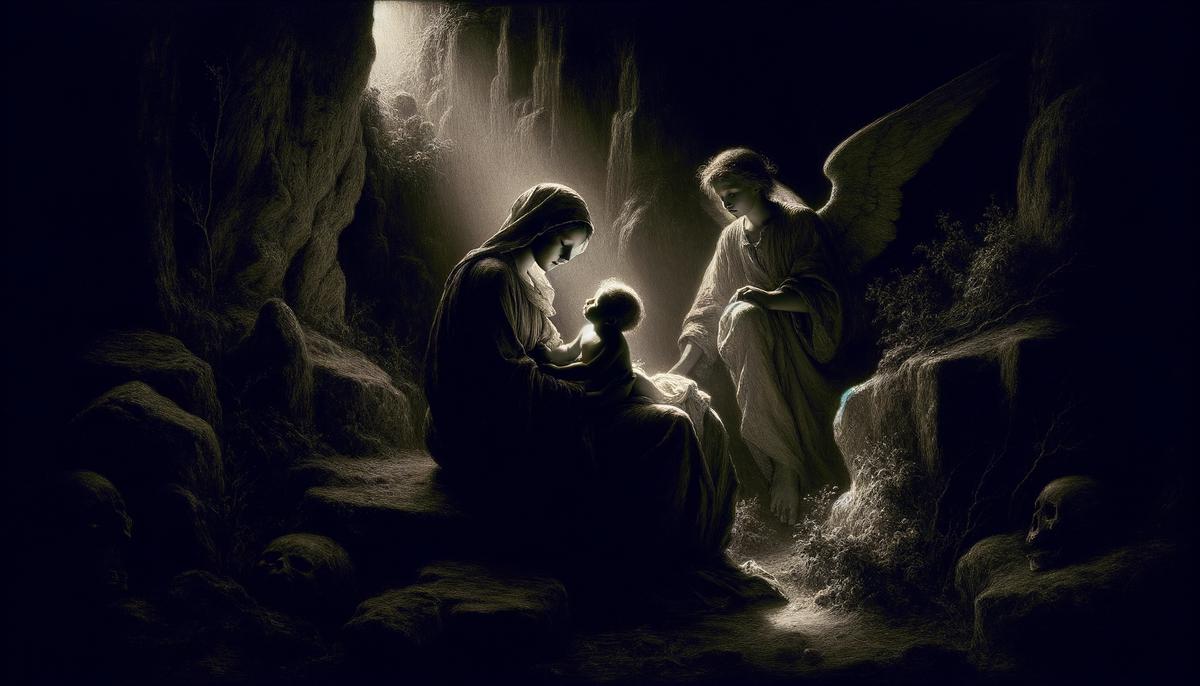
5. Rain, Steam and Speed
In the midst of the National Gallery's treasure-rich halls, "Rain, Steam and Speed" by J.M.W. Turner emerges as a dialogue between eras, skillfully encapsulating the artist's nuanced relationship with progress. At first sight, the work thrums with vitality; a steam engine barrels forward, cutting through a landscape caught in the thrall of a storm. This is Turner at his most evocative, painting not what he sees, but what he feels, transforming a mere moment into an eternal question: Is progress always a storm we must weather?
The canvas teeters on the edge of abstraction, a significant departure from the pastoral serenity that typified much of the art before the industrial age. In Turner's hands, the fierce advance of the train symbolizes technological progress and a metaphorical storm—of culture, society, and human identity itself, all in the inexorable move forward. Yet, there's more to it than a straightforward lament for times gone past or an unbridled exaltation of the future.
Turner's brushstrokes imbue the scenery with a tumultuous beauty, suggesting an awe in the face of progress's mighty force rather than outright fear or endorsement. The train, a literal machine of progress, seems both to combat and meld with the elemental fury around it — steam and speed become indistinguishable from the rain and wind. It's this interplay that poses the silent query: could it be that progress and nature are not adversaries but participants in a grander design?
Amidst the chaos wrought by the train's passage, the landscape, while undoubtedly altered, retains its own form of enduring majesty. It's as if the painting whispers a subtle truth that progress, for all its storms, doesn't obliterate the natural world but recontextualizes our appreciation and experience of it.
Despite the undeniable power and potential destruction that progress heralds, there's an undercurrent of hope woven into Turner's tempest. The striking juxtaposition of natural and mechanical forces doesn't serve as an obituary for what's left behind but rather as a testament to resilience — that both land and humanity possess an innate capacity to endure and adapt amidst the advance of civilizations.
"Rain, Steam and Speed" stands as one of Turner's most profound meditations on progress. It compels the viewer to ponder. Does Turner celebrate progress, or mourn the pastoral? Perhaps the real beauty lies in the ambiguity – in the understanding that progress, like a storm, can be both destructive and revitalizing. Turner's masterwork leaves us with a notion encapsulated perfectly within its tempestuous frame: that beauty and understanding can be found in navigating tumultuous waters, revealing that progress might just be a storm worth enduring.
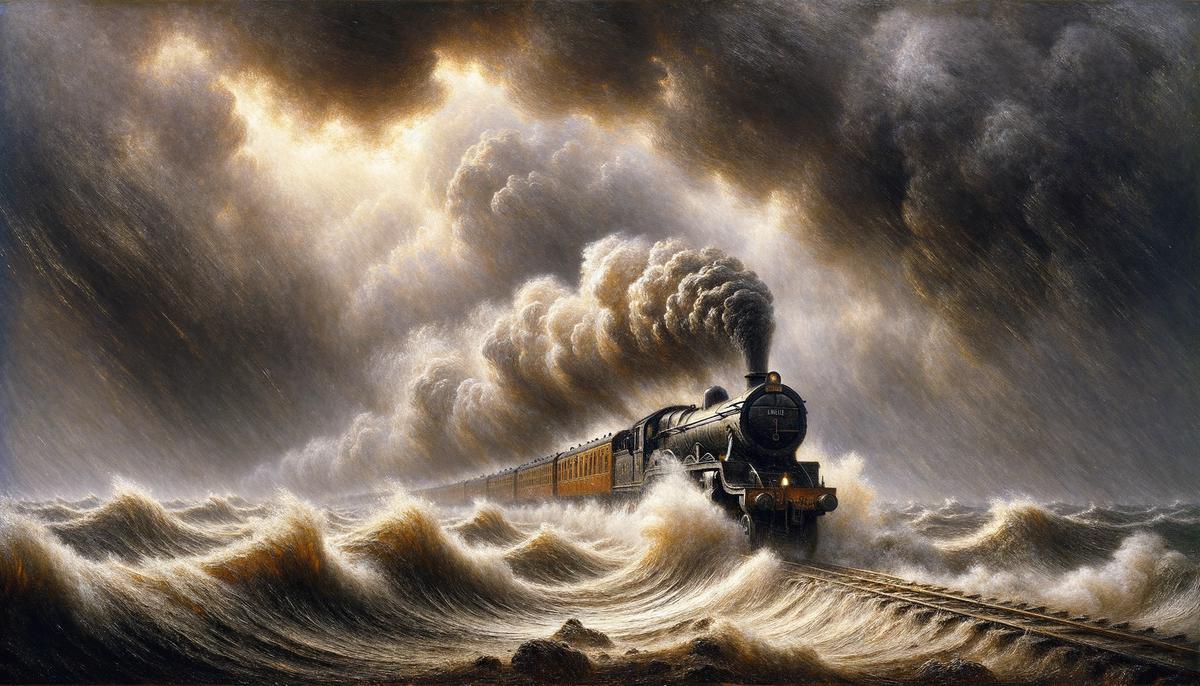
6. Bathers at Asnieres
Georges Seurat's "Bathers at Asnieres" reflects the complexities of its era. With every dot carefully placed on the canvas, Seurat invites us to engage in a dialogue deeper than the serene river before us. Seurat doesn't merely offer visual treats; he presents a narrative with socio-political undertones.
At first, "Bathers at Asnieres" appears as a picturesque summer's day where young Parisians are untouched by the cares of the world. The sun caresses their skin, and the Seine flows gently. It might seem an ode to collective harmony, preserving a moment of shared serenity amidst the industrial clamor of Paris.
But Seurat's work is meticulously calculated, each dot an echo of Paris's social stratification. The bathers, while in a moment of leisure, are undeniably working class – their presence by the river a respite from industrial labor.1 They occupy the forefront, yet they do not engage with each other; their gazes are disconnected, potentially symbolizing their alienation within the modernizing society.
In the distance, smokestacks peer over the horizon – indicative of the industrial forces at play. These chimneys serve as markers of contrast to the idyllic foreground, hinting at modernity's dual nature as both creator and destroyer of community bonds.
Seurat's work crafts an alternative narrative beneath the guise of leisure. Rather than celebrating an idealized harmony, Seurat scrutinizes the evolving urban landscape and its impact on societal interactions. The separation of class and isolation portrayed provide a commentary on modernity, questioning whether progress inevitably comes with a partitioning of society.
"Bathers at Asnieres" transcends its leisurely facade, laying bare the complexities of a society in transformation. Seurat's scene emerges as a reflective prism through which the evolutions of urban life and social disjunctions are subtly scrutinized.
The work oscillates between a tranquil depiction of leisure and a critique of modernity's segregations. A celebration on the surface perhaps masks a critique at its core — indicating that in Seurat's cosmos of dots, harmony and discord are two sides of the same canvas. Seurat adeptly marries form with function, inviting us to ponder not only what we see but also what we overlook in our quest to fathom modern life.
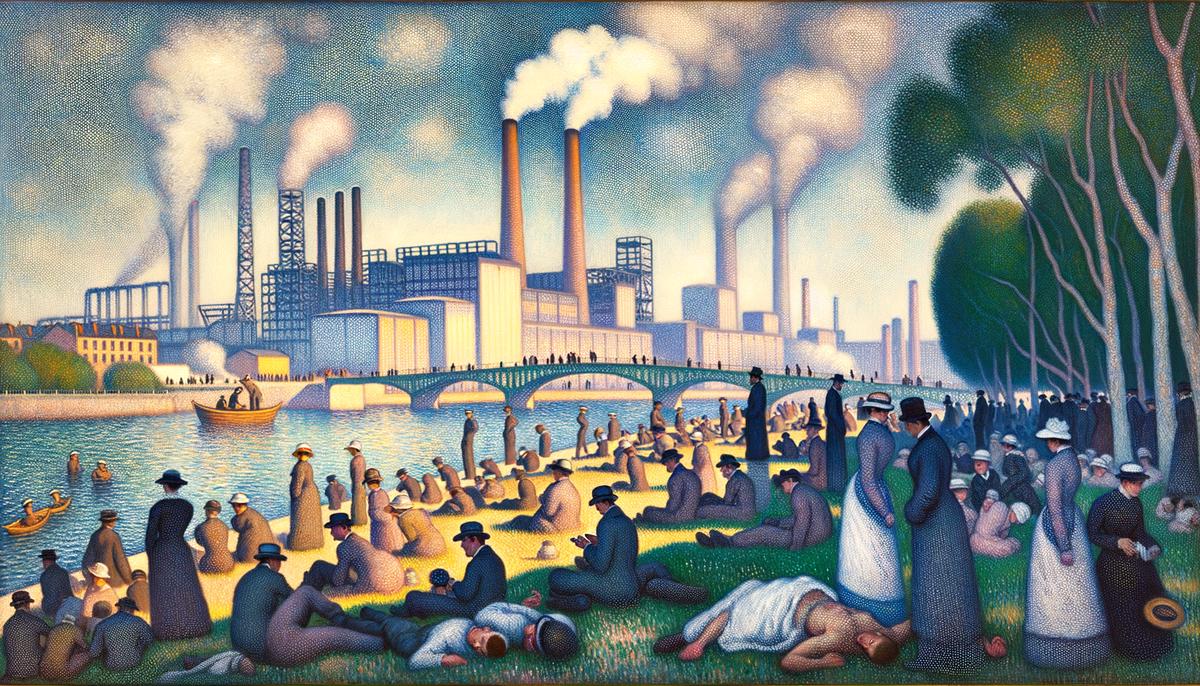
Art has the power to evoke empathy and reflection, bridging the gap between the viewer and the subject. By engaging with these masterpieces on an emotional level, we are reminded of our shared humanity and the enduring impact of creativity across time. This connection underscores the importance of preserving and cherishing these cultural treasures for future generations to appreciate.






















